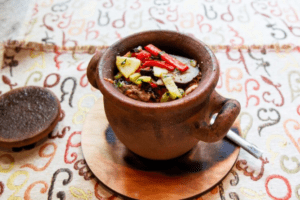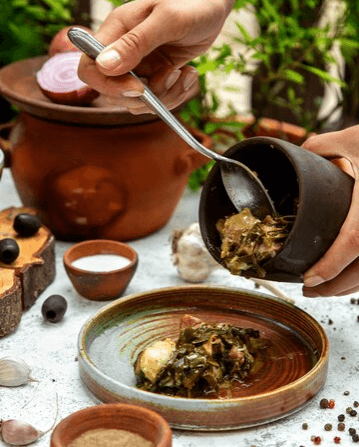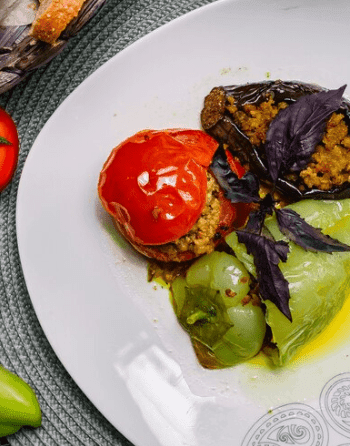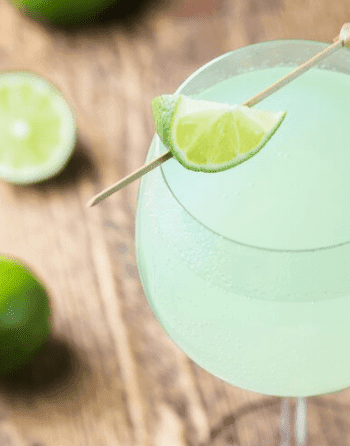Molcajetes are not just cooking tools; they are the soul of Mexican cuisine. This authentic mortar and pestle has been used for centuries to prepare everything from salsas to hearty meat dishes, creating a unique culinary experience like no other. Whether you’re a seasoned cook or just discovering Mexican flavors, a molcajete recipe offers endless opportunities for creativity in the kitchen.
In this article, we’ll explore some of the best ways to use a molcajete, from traditional salsas to mouth-watering mixed grills. If you want to dive deeper into the origins and cultural significance of the molcajete, check out this detailed recipe that features an authentic preparation method from La Piña en la Cocina. By the end of this article, you’ll be well-equipped to prepare your own molcajete feast and impress your guests.
What is a Molcajete Recipe?
The molcajete is a traditional Mexican stone mortar and pestle made from volcanic rock. Its rough texture is perfect for grinding and mixing ingredients, which helps release their full flavor. Originating from ancient Mexican civilizations, the molcajete has remained a staple in kitchens throughout the country. The mortar typically sits on three small legs, making it stable during use.
If you’re new to using a molcajete, it’s worth noting that it’s not just for making salsa. This versatile kitchen tool is perfect for preparing dishes like guacamole, marinades, and even grinding spices. Whether you’re a fan of authentic Mexican recipes or looking to try something new, this traditional tool adds depth to your cooking.
Choosing the Right Molcajete Recipe
When selecting a molcajete, you’ll find options made from various materials. The best choice is a traditional volcanic stone molcajete, which is durable and effective for grinding. The stone’s texture allows for easy crushing and blending of ingredients, making it ideal for authentic salsa recipes.
- Volcanic stone molcajetes are known for their durability and ideal grinding surface.
- Size matters: If you’re preparing large batches, consider a bigger molcajete.
- Quality check: Look for well-made molcajetes, free from cracks, for longevity and efficient use.
To learn more about selecting the right molcajete for your needs, take a look at this molcajete buying guide.
Curing Your molcajete recipe:
Before you can start creating your favorite salsas, guacamoles, and other dishes in your new molcajete, it’s crucial to cure the stone. The curing process removes any residual grit or dust left behind from the manufacturing process, ensuring that your molcajete is safe to use for food preparation. It also helps smooth the grinding surface, making it more effective for blending ingredients, and ensures that your food tastes fresh without any unwanted stone particles.
Why Is Curing Important?
The curing process is essential because a molcajete made from volcanic rock can contain fine stone dust that may affect the flavor of your food. Additionally, the rough texture of the stone can make it difficult to grind ingredients smoothly without first preparing the surface. By curing your molcajete, you ensure that it will function at its best, improving both the grinding efficiency and the overall taste of your dishes.
How to Cure a Molcajete Recipe:
Step 1: Rinse the Molcajete
Start by rinsing your molcajete with warm water. Use a gentle scrub brush or sponge to remove any dust or debris from the surface. It’s important to rinse the entire interior and exterior of the stone to ensure there’s no leftover stone grit or loose particles.
- Tip: Avoid using soap at this stage. The stone is porous, and soap can seep into the surface, potentially affecting the flavor of your food later.
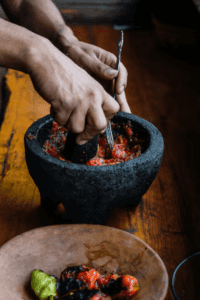
Step 2: Grind Rice in the Molcajete
After rinsing the molcajete, the next step is to grind rice in it. This serves two purposes:
- Removing Excess Stone Dust: The rice grains help scrape off any fine particles of stone dust that may still be lingering in the molcajete.
- Smoothening the Surface: As the rice is ground, it polishes the rough interior of the molcajete, making it easier to grind ingredients evenly in the future.
To do this:
- Pour a small handful of uncooked rice into the molcajete.
- Use the pestle to grind the rice in a circular motion, pressing down firmly. Continue grinding until the rice turns into a fine powder, which usually takes about 5–10 minutes.
- Dispose of the rice powder when done.
You may need to repeat this step a few times to ensure that all excess grit has been removed. After the grinding process, rinse the molcajete with water again to remove any leftover rice powder.
Step 3: Grind Garlic and Salt Together
The next step in curing your molcajete is to season it. This not only further cleans the surface but also helps to improve the texture of the stone. By grinding garlic and salt together, you are enhancing the flavor absorption of the molcajete, making it ready for future dishes.
Here’s how to do it:
- Peel one or two garlic cloves and add them to the molcajete, along with a pinch of coarse salt (preferably sea salt or kosher salt).
- Use the pestle to grind the garlic and salt together. The salt will help scrub the molcajete’s interior and continue smoothing the rough texture of the stone.
- After grinding, let the mixture sit in the molcajete for a few minutes to allow the stone to absorb the garlic and salt flavors.
Once you’re done, rinse the molcajete again with warm water to remove any remaining garlic and salt mixture.
Step 4: Dry and Let Rest
Once the curing process is complete, let the molcajete dry naturally. You can leave it on a clean towel or place it in a dry, well-ventilated area for a few hours. This resting period allows the stone to fully absorb the flavors of the garlic and salt, making it even more effective for grinding.
- Note: After the curing process, your molcajete is now ready to be used for preparing flavorful salsas, moles, or marinades.
Additional Tips for Maintaining Your Molcajete
- Always rinse your molcajete with warm water after use. Do not use soap or detergents as it can seep into the porous stone and affect the taste of your food.
- Store your molcajete in a dry place to prevent mold or mildew buildup.
- To prolong its life, consider seasoning it with salt occasionally if you notice it becoming too rough over time.
Check out our Mexican breakfast recipes
Now that your molcajete is fully cured, it’s time to dive into some delicious recipes. One of the most popular and delicious dishes you can prepare in your molcajete is Salsa Roja. Here’s how to make it:
Molcajete Recipe Salsa Roja
A molcajete salsa roja is a spicy red salsa that blends roasted tomatoes, chiles, garlic, and onions into a rich and flavorful sauce. This versatile salsa can be used as a topping for tacos, grilled meats, or even as a dip for tortilla chips. The molcajete brings out the best flavors by grinding and mixing the ingredients to perfection.
Ingredients:
- 3 ripe tomatoes
- 2 dried chiles (such as ancho or guajillo)
- 1 garlic clove
- 1 small onion
- Salt to taste
Instructions: Molcajete Recipe
- Roast the Tomatoes, Garlic, and Onion:
- Place the tomatoes, garlic, and onion on a dry skillet or comal over medium heat.
- Roast them for 5-7 minutes until they are soft and slightly charred. Be sure to turn them occasionally to prevent burning.
- Once roasted, remove the tomatoes and garlic from the heat and set them aside to cool. The onion can stay in the pan for a few more minutes to get a nice caramelized edge.
- Grind the Chiles in Your Molcajete:
- Remove the stems and seeds from the dried chiles, then place them into the molcajete.
- Grind the chiles into a fine paste, using circular motions with the pestle.
- Add the Roasted Ingredients:
- Add the roasted tomatoes, garlic, and onion into the molcajete. Continue grinding the mixture until everything is well-blended, with a slightly chunky texture.
- Season to Taste:
- Once the salsa is smooth and well-combined, taste it and add salt to your preference. You can also add a little lime juice or a pinch of cumin for extra flavor.
- Serve and Enjoy:
- Serve your fresh molcajete salsa roja immediately over your favorite Mexican dishes, such as tacos, grilled meats, or alongside crispy tortilla chips.
This recipe makes an excellent pairing for any grilled dishes, including those prepared in a molcajete. For more ideas on salsa preparation, check out Rick Bayless’s authentic salsa de molcajete.
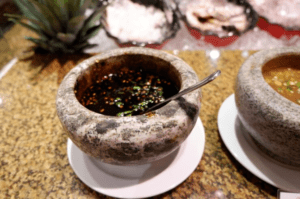
Molcajete Recipe Mixto (Mixed Grill)
If you want to elevate your molcajete experience, try making a molcajete mixto. This hearty dish combines grilled meats like beef, chicken, and shrimp with vegetables, all served in the molcajete for a sizzling presentation.
Ingredients: Molcajete Recipe
- 1 lb beef, chicken, and shrimp (cut into bite-sized pieces)
- 1 bell pepper, sliced
- 1 onion, sliced
- 1 zucchini, sliced
- Marinade of choice (citrus-based or garlic-infused)
Instructions:
- Marinate the meats for at least 30 minutes.
- Grill the meat and vegetables until cooked to your desired level.
- Place everything in a heated molcajete and serve immediately for a sizzling, flavorful experience.
This recipe is perfect for sharing with family and friends during special occasions. The sizzling presentation adds to the fun, making it an unforgettable meal.
Traditional Accompaniments for Molcajete Recipe
While the molcajete itself provides a flavorful centerpiece, it’s important to include some traditional sides to complete the meal.
- Mexican rice: A savory rice dish with tomatoes and spices.
- Refried beans: Smooth and creamy beans for a hearty side.
- Corn tortillas: Soft, homemade tortillas perfect for scooping up your molcajete dishes.
- Aguas frescas: Fresh fruit beverages to balance the spice.
These accompaniments will complement the rich flavors of the molcajete and enhance the overall dining experience.
For a breakfast option that perfectly complements the molcajete’s flavors, consider adding a classic Mexican dish like molletes to your menu. They’re a great way to start the day with something hearty and satisfying.
FAQs about Molcajete Recipes
What is a traditional molcajete made of?
A traditional molcajete is made of volcanic stone, often basalt or lava rock, which gives it durability and a unique texture ideal for grinding and mixing ingredients. The molcajete stone is prized for its ability to retain and distribute heat evenly, which makes it perfect for preparing traditional Mexican dishes such as salsa de molcajete or guacamole. This stone tool has been used for centuries in Mexican cuisine, bringing an authentic and rustic charm to every meal.
What is molcajete sauce made of?
Molcajete sauce is typically made from a combination of roasted ingredients, such as tomatoes, garlic, onions, and chiles. These ingredients are ground in the molcajete, releasing their natural flavors and oils to create a vibrant, flavorful sauce. The most popular variation of molcajete sauce is salsa roja, which combines roasted tomatoes and dried chiles like ancho or guajillo. This sauce is perfect for topping tacos, grilled meats, or using as a dip for chips.
What do you put in a molcajete?
In a molcajete, you can put a wide variety of ingredients, depending on the dish you’re preparing. Some of the most common items include fresh herbs, spices, tomatoes, garlic, onions, and chiles. Popular uses for the molcajete include making salsa de molcajete, guacamole, or pastes for marinades. The unique texture of the molcajete stone helps to release the natural oils and juices from the ingredients, creating a richer flavor profile.
What is the point of a molcajete?
The point of a molcajete is to create a more authentic and flavorful cooking experience. The stone grinder helps release the natural oils, juices, and flavors of fresh ingredients like tomatoes, garlic, and chiles in a way that modern blenders can’t replicate. Whether used for grinding spices, mixing salsas, or preparing mole, the molcajete enhances the texture and flavor of dishes, making it an essential tool in Mexican cooking. It not only adds a rustic touch to your kitchen but also brings out the full potential of your ingredients.
